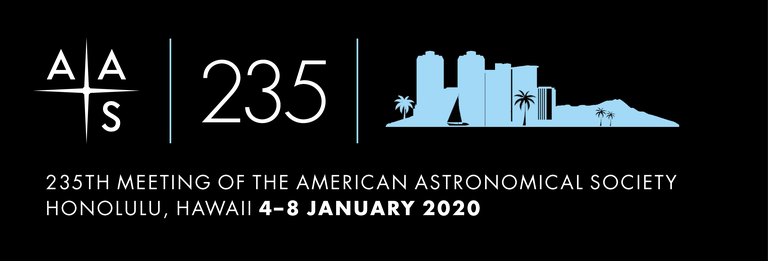235th AAS Meeting
NRAO Town Hall
 |
American Astronomical Society winter meeting
|
|---|
This Town Hall will inform the AAS membership about the status of science, science operations, and development programs at the National Radio Astronomy Observatory (NRAO). An opening reception will be followed by a brief presentation that will update the membership regarding: (a) scientific opportunities and technical development at the Atacama Large Millimeter/submillimeter Array (ALMA), the Karl G. Jansky Very Large Array (VLA), and the Very Long Baseline Array (VLBA); (b) recent science results from across the community and the Observatory; and (c) scientific and technical planning for future radio astronomy research facilities, including a next generation Very Large Array (ngVLA).
Confirmed speakers:
- Tony Beasley (NRAO Director)
- Amy Kimball (VLA Sky Survey Scientist)
- Eric Murphy (ngVLA Project Scientist)
The Scientific Quest for High Angular Resolution
 |
American Astronomical Society winter meeting
|
|---|
The NRAO and the ngVLA Project convened a Special Session entitled "The Scientific Quest for High Angular Resolution" on 7 January 2020 at the American Astronomical Society (AAS) winter meeting.
Sensitive ground- and space-based astronomical observations acquired at high angular resolution are enabling new insights across many frontier fields of astrophysics, such as star and planet formation. At the dawn of multi-messenger astrophysics, radio-wavelength follow-up at high angular resolution of gravitational wave sources is providing critical insights into the energetics and evolution of these events. Improvements in observations at high angular resolution are also enabling deep proper-motion measurements and surveys, vastly increasing the cosmic volume across which scientists can meaningfully observe protoplanetary disk formation, black hole feeding, jet launching, Local Group dynamics, and much more. These observational insights are propagating into a much improved theoretical understanding of the physics driving each of these frontier fields.
This Special Session:
- Highlighted recent scientific breakthroughs enabled by imaging at high angular resolution;
- Described planned near- and long-term resolution improvements for ground- and space-based facilities;
- Discussed major scientific leaps likely to result from even higher angular resolution across the electromagnetic spectrum; and
- Reviewed the importance of high angular resolution to the high-priority science themes of the great observatories to be commissioned in the next decade.
This Special Session featured a session of invited oral presentations and an associated poster session with contributed presentations. The Special Session's science program appears below.
Presentations can be downloaded by clicking on the presentation titles.
Breakthrough Science with the Atacama Large Millimeter/submillimeter Array
 |
American Astronomical Society winter meeting
|
|---|

This AAS Special Session will update the community on the capabilities, news, and science from the Atacama Large Millimeter/submillimeter Array (ALMA). ALMA is among the largest multi-national science projects in the world, and has been conducting astronomical observations since October 2011. Now in Full Operations, ALMA Cycle 7 science observing will begin in October 2019.
ALMA is a complete imaging and spectroscopic telescope operating at millimeter and submillimeter wavelengths. It offers an unprecedented new look at our Universe near and far, from direct imaging of planet formation to groundbreaking observations of the first stars and galaxies. ALMA provides unprecedented sensitivity, image fidelity, and angular resolution at these wavelengths and enables forefront research with stunning images and spectroscopy.
This Special Session will feature an overview on the status of the Joint ALMA Observatory by the ALMA Director followed by invited science talks that highlight recent results from the first ALMA Large programs, results from the Event Horizon Telescope (EHT), and breakthrough results from other ALMA projects. The science talks will include: (1) the molecular and physical origins of planetary systems as observed by the Disk Substructures at High Angular Resolution Project (DSHARP) and others; (2) direct imaging of the supermassive black hole in M87 via Very Long Baseline Interferometry using the EHT; (3) the interplay between the small-scale physics of gas and star formation with galactic structure and evolution as studied by the Physics at High Angular resolution in Nearby GalaxieS (PHANGS) project; and (4) the ALMA Spectroscopic Survey in the Hubble Ultra Deep Field (ASPECS) project. We will also describe the role of the North American ALMA Science Center in supporting Principal Investigator and archival research by North American investigators.
ALMA, an international astronomy facility, is a partnership of ESO (representing its member states), NSF (USA) and NINS (Japan), together with NRC (Canada), MOST and ASIAA (Taiwan), and KASI (Republic of Korea), in cooperation with the Republic of Chile.






Connect with NRAO